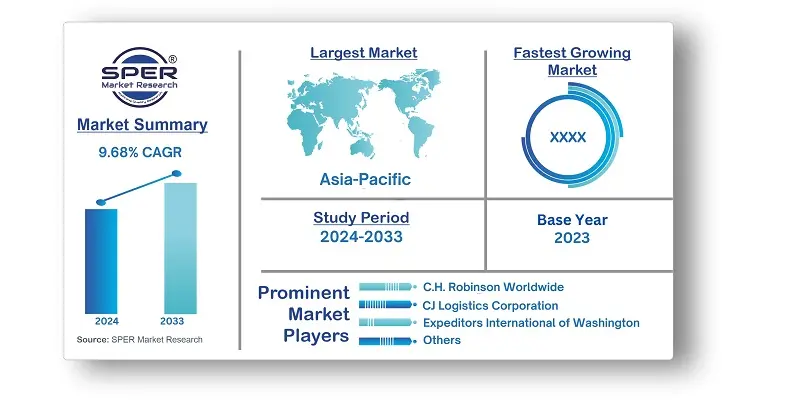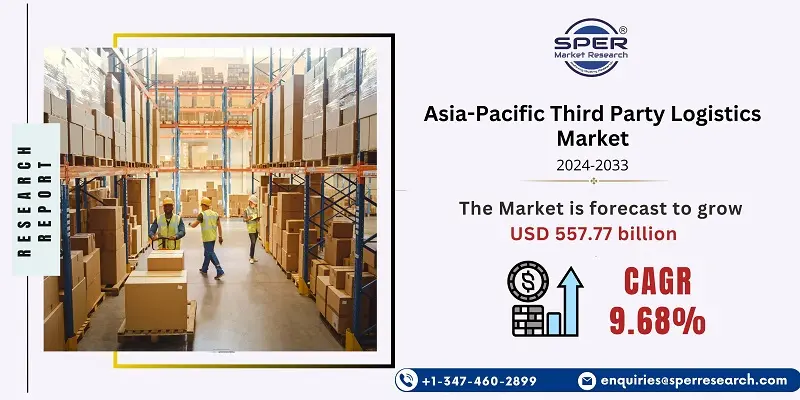
Asia-Pacific Third Party Logistics Market Growth, Size, Trends, Share, Demand and Future Outlook
Asia-Pacific Third Party Logistics Market Size- By Service, By Transport, By End User- Regional Outlook, Competitive Strategies and Segment Forecast to 2033
| Published: Jun-2024 | Report ID: AMIN24146 | Pages: 1 - 152 | Formats*: |
| Category : Automotive & Transportation | |||
- The foreign sellers on eBay Hong Kong and eBay China who are based in the US market have Lecangs as a logistics partner since April 2022.


| Report Metric | Details |
| Market size available for years | 2020-2033 |
| Base year considered | 2023 |
| Forecast period | 2024-2033 |
| Segments covered | By Service, By Transport, By End Use |
| Regions covered | Australia, China, India, Japan, South Korea, Rest of Asia-Pacific |
| Companies Covered | C.H. Robinson Worldwide, Inc., CJ Logistics Corporation, DHL International GmbH (a subsidiary of Deutsche Post AG), DSV, Expeditors International of Washington, Inc., FedEx, Kintetsu World Express, Inc., Kuehne+Nagel, Nippon Express Co., Ltd., Samudera Shipping Line Ltd, Schenker AG, Singapore, SNCF, Toll Holdings Limited (a subsidiary of Japan Post Holdings Co.,Ltd.), United Parcel Service of America, Inc., XPO Logistics, Inc. |
- Retail and E-commerce Companies
- Manufacturing Industries
- Automotive Sector
- Healthcare and Pharmaceutical Companies
- Food and Beverage Sector
- High-Tech and Electronics Industries
- Government and Defense
- Energy and Chemicals
| By Service: |
|
| By Transport: |
|
| By End User: |
|
- Asia-Pacific Third Party Logistics Market Size (FY’2024-FY’2033)
- Overview of Asia-Pacific Third Party Logistics Market
- Segmentation of Asia-Pacific Third Party Logistics Market By Service {Dedicated Contract Carriage (DCC)/Freight forwarding, Domestic Transportation Management (DTM), International Transportation Management (ITM), Warehousing &Distribution (W&D), Value Added Logistics Services (VALs)}
- Segmentation of Asia-Pacific Third Party Logistics Market By Transport (Roadways, Railways, Waterways, Airways)
- Segmentation of Asia-Pacific Third Party Logistics Market By End User (Manufacturing, Retail, Healthcare, Automotive, Others)
- Expansion Analysis of Asia-Pacific Third Party Logistics Market
- Problems and Obstacles in Asia-Pacific Third Party Logistics Market
- Competitive Landscape in the Asia-Pacific Third Party Logistics Market
- Impact of COVID-19 and Demonetization on Asia-Pacific Third Party Logistics Market
- Details on Current Investment in Asia-Pacific Third Party Logistics Market
- Competitive Analysis of Asia-Pacific Third Party Logistics Market
- Prominent Players in the Asia-Pacific Third Party Logistics Market
- SWOT Analysis of Asia-Pacific Third Party Logistics Market
- Asia-Pacific Third Party Logistics Market Future Outlook and Projections (FY’2024-FY’2033)
- Recommendations from Analyst
1.1. Scope of the report1.2. Market segment analysis
2.1. Research data source2.1.1. Secondary Data2.1.2. Primary Data2.1.3. SPER’s internal database2.1.4. Premium insight from KOL’s2.2. Market size estimation2.2.1. Top-down and Bottom-up approach2.3. Data triangulation
4.1. Driver, Restraint, Opportunity and Challenges analysis4.1.1. Drivers4.1.2. Restraints4.1.3. Opportunities4.1.4. Challenges4.2. COVID-19 Impacts of the Asia-Pacific Third Party Logistics Market
5.1. SWOT Analysis5.1.1. Strengths5.1.2. Weaknesses5.1.3. Opportunities5.1.4. Threats5.2. PESTEL Analysis5.2.1. Political Landscape5.2.2. Economic Landscape5.2.3. Social Landscape5.2.4. Technological Landscape5.2.5. Environmental Landscape5.2.6. Legal Landscape
5.3. PORTER’s Five Forces
5.3.1. Bargaining power of suppliers5.3.2. Bargaining power of buyers5.3.3. Threat of Substitute5.3.4. Threat of new entrant5.3.5. Competitive rivalry5.4. Heat Map Analysis
6.1. Asia-Pacific Third Party Logistics Market Manufacturing Base Distribution, Sales Area, Product Type6.2. Mergers & Acquisitions, Partnerships, Product Launch, and Collaboration in Asia-Pacific Third Party Logistics Market
7.1. Asia-Pacific Third Party Logistics Market Size, Share and Forecast, By Service, 2020-20267.2. Asia-Pacific Third Party Logistics Market Size, Share and Forecast, By Service, 2027-20337.3. Dedicated Contract Carriage (DCC)/Freight forwarding7.4. Domestic Transportation Management (DTM)7.5. International Transportation Management (ITM)7.6. Warehousing &Distribution (W&D)7.7. Value Added Logistics Services (VALs)
8.1. Asia-Pacific Third Party Logistics Market Size, Share and Forecast, By Transport, 2020-20268.2. Asia-Pacific Third Party Logistics Market Size, Share and Forecast, By Transport, 2027-20338.3. Roadways8.4. Railways8.5. Waterways8.6. Airways
9.1. Asia-Pacific Third Party Logistics Market Size, Share and Forecast, By End User, 2020-20269.2. Asia-Pacific Third Party Logistics Market Size, Share and Forecast, By End User, 2027-20339.3. Manufacturing9.4. Retail9.5. Healthcare9.6. Automotive9.7. Others
10.1. Asia-Pacific Third Party Logistics Market Size and Market Share
11.1. Asia-Pacific Third Party Logistics Market Size and Market Share By Region (2020-2026)11.2. Asia-Pacific Third Party Logistics Market Size and Market Share By Region (2027-2033)11.3. Australia11.4. China11.5. India11.6. Japan11.7. South Korea11.8. Rest of Asia-Pacific
12.1. C.H. Robinson Worldwide, Inc.12.1.1. Company details12.1.2. Financial outlook12.1.3. Product summary12.1.4. Recent developments12.2. CJ Logistics Corporation12.2.1. Company details12.2.2. Financial outlook12.2.3. Product summary12.2.4. Recent developments12.3. DHL International GmbH (a subsidiary of Deutsche Post AG)12.3.1. Company details12.3.2. Financial outlook12.3.3. Product summary12.3.4. Recent developments12.4. DSV12.4.1. Company details12.4.2. Financial outlook12.4.3. Product summary12.4.4. Recent developments12.5. Expeditors International of Washington, Inc.12.5.1. Company details12.5.2. Financial outlook12.5.3. Product summary12.5.4. Recent developments12.6. FedEx12.6.1. Company details12.6.2. Financial outlook12.6.3. Product summary12.6.4. Recent developments12.7. Kintetsu World Express, Inc.12.7.1. Company details12.7.2. Financial outlook12.7.3. Product summary12.7.4. Recent developments12.8. Kuehne+Nagel12.8.1. Company details12.8.2. Financial outlook12.8.3. Product summary12.8.4. Recent developments12.9. Nippon Express Co., Ltd.12.9.1. Company details12.9.2. Financial outlook12.9.3. Product summary12.9.4. Recent developments12.10. Samudera Shipping Line Ltd12.10.1. Company details12.10.2. Financial outlook12.10.3. Product summary12.10.4. Recent developments12.11. Schenker AG12.11.1. Company details12.11.2. Financial outlook12.11.3. Product summary12.11.4. Recent developments12.12. Singapore12.12.1. Company details12.12.2. Financial outlook12.12.3. Product summary12.12.4. Recent developments12.13. SNCF12.13.1. Company details12.13.2. Financial outlook12.13.3. Product summary12.13.4. Recent developments12.14. Toll Holdings Limited (a subsidiary of Japan Post Holdings Co.,Ltd.)12.14.1. Company details12.14.2. Financial outlook12.14.3. Product summary12.14.4. Recent developments12.15. United Parcel Service of America, Inc.12.15.1. Company details12.15.2. Financial outlook12.15.3. Product summary12.15.4. Recent developments12.16. Others
SPER Market Research’s methodology uses great emphasis on primary research to ensure that the market intelligence insights are up to date, reliable and accurate. Primary interviews are done with players involved in each phase of a supply chain to analyze the market forecasting. The secondary research method is used to help you fully understand how the future markets and the spending patterns look likes.
The report is based on in-depth qualitative and quantitative analysis of the Product Market. The quantitative analysis involves the application of various projection and sampling techniques. The qualitative analysis involves primary interviews, surveys, and vendor briefings. The data gathered as a result of these processes are validated through experts opinion. Our research methodology entails an ideal mixture of primary and secondary initiatives.



Frequently Asked Questions About This Report
PLACE AN ORDER
Year End Discount
Sample Report
Pre-Purchase Inquiry
NEED CUSTOMIZATION?
Request CustomizationCALL OR EMAIL US
100% Secure Payment






Related Reports
Our Global Clients
Our data-driven insights have influenced the strategy of 200+ reputed companies across the globe.




















